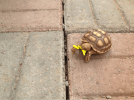Hey every body just I'm new to this and just wanted to introduce myself and say hey. I'm jessica and I just got a baby sulcata a few months ago an I love him. We named him spike which seems to be a pretty popular name in the tortoise world. I feed him Timothy hay mixed with zoo med grassland tortoise food and nature zone juvenile baby bites. I give him all of that mixed together every other day. Was to
D they don't need to eat every day. I also have turtle cuttle bones in his tank for him to eat at any time. For bedding I use Zella's bark blend. The humidity is only at about 35% and it it hard to keep it much higher than that. The temp on the basking side is around 85 during the day. He seems very happy and healthy and I think I'm doing everything right but every day I learn something new so any tips or advise would be much appreciated. Thanks and I'm really enjoying this site. Jessica

Spike eating a dandelion
D they don't need to eat every day. I also have turtle cuttle bones in his tank for him to eat at any time. For bedding I use Zella's bark blend. The humidity is only at about 35% and it it hard to keep it much higher than that. The temp on the basking side is around 85 during the day. He seems very happy and healthy and I think I'm doing everything right but every day I learn something new so any tips or advise would be much appreciated. Thanks and I'm really enjoying this site. Jessica

Spike eating a dandelion